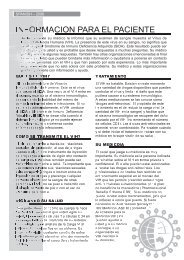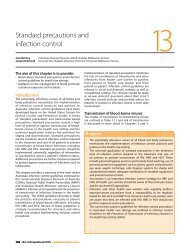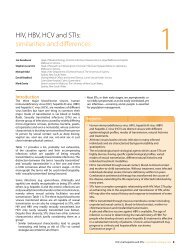B Positive – all you wanted to know about - ASHM
B Positive – all you wanted to know about - ASHM
B Positive – all you wanted to know about - ASHM
Create successful ePaper yourself
Turn your PDF publications into a flip-book with our unique Google optimized e-Paper software.
Executive Summary<br />
this monograph aims <strong>to</strong> provide primary<br />
care practitioners with an overview of<br />
current hepatitis b <strong>know</strong>ledge in australia—<br />
a field which is constantly changing and<br />
evolving. it is not intended <strong>to</strong> be read as a<br />
cover-<strong>to</strong>-cover text, but rather <strong>to</strong> be referred<br />
<strong>to</strong> as an information resource for advice<br />
and explanation of issues that may arise<br />
in clinical practice. chapters 1 <strong>to</strong> 5 deal<br />
with the theory of hepatitis b disease from<br />
australian epidemiology through <strong>to</strong> virology,<br />
natural his<strong>to</strong>ry, interpretation of hepatitis b<br />
tests and vaccination. chapters 6 <strong>to</strong> 10 are<br />
more practic<strong>all</strong>y based, and deal with the<br />
assessment and treatment of the hepatitis<br />
b-positive patient, the management of<br />
advanced liver disease and hepa<strong>to</strong>cellular<br />
carcinoma (Hcc) and complex situations, such<br />
as pregnancy and HiV co-infection. chapter<br />
11: infection control and occupational health<br />
and chapter 12: Privacy, confidentiality<br />
and other legal responsibilities deal with<br />
occupational and legal issues surrounding<br />
hepatitis b. chapter 13 explores the role of<br />
alternative or complementary therapies.<br />
the information contained in many of the<br />
chapters is related, or has relevance, <strong>to</strong><br />
material in other chapters. Hyperlinks placed<br />
at the start of each chapter in the electronic<br />
version and through the text <strong>all</strong>ow the reader<br />
<strong>to</strong> move between related <strong>to</strong>pics as required.<br />
internet and other related resources that may<br />
be helpful for the providers involved in the<br />
assessment and management of hepatitis<br />
b-positive patients, along with a patient fact<br />
sheet, are also included for further reference.<br />
the effective prevention and management<br />
of hepatitis b virus (HbV) infection<br />
represents a major ch<strong>all</strong>enge <strong>to</strong> health care<br />
providers within australia <strong>to</strong>day. recent<br />
years have seen significant advances in the<br />
management of hepatitis b disease, with the<br />
8 b <strong>Positive</strong> <strong>–</strong> <strong>all</strong> <strong>you</strong> <strong>wanted</strong> <strong>to</strong> <strong>know</strong> <strong>about</strong> hepatitis b: a guide for primary care providers<br />
wider availability of new sensitive diagnostic<br />
tests and effective therapies, coupled with<br />
a better understanding of the complex<br />
virology and natural his<strong>to</strong>ry of hepatitis<br />
b. such developments have heightened<br />
awareness of the need <strong>to</strong> effectively target<br />
those at risk for vaccination and treatment.<br />
the implementation of appropriate strategies<br />
is likely <strong>to</strong> have a major impact on the<br />
burden of hepatitis b-related disease, and in<br />
particular primary liver cancer (hepa<strong>to</strong>cellular<br />
carcinoma), in australia in<strong>to</strong> the future. the<br />
achievement of these goals rests largely with<br />
the primary care provider, both <strong>to</strong> screen<br />
and vaccinate those at potential risk of<br />
hepatitis b, and <strong>to</strong> identify, refer and moni<strong>to</strong>r<br />
those who may benefit from anti-hepatitis b<br />
therapy. this monograph aims <strong>to</strong> update and<br />
inform the primary care clinician on current<br />
<strong>know</strong>ledge regarding hepatitis b infection.<br />
the epidemiology of hepatitis b is discussed<br />
in chapter 1: Prevalence and epidemiology<br />
of hepatitis b. World Health organization<br />
(WHo) estimates indicate that over 400<br />
million people worldwide have hepatitis b<br />
infection, the majority of whom live in the<br />
developing world. the asia-Pacific region<br />
bears one of the highest burdens of hepatitis<br />
b infection, with a prevalence rate of more<br />
than 8% throughout the region. Migration<br />
from asian countries, in particular china<br />
and Vietnam, is largely responsible for the<br />
increasing prevalence of chronic hepatitis b<br />
and its complications in australia in recent<br />
years. almost half of the primary liver<br />
cancers diagnosed in australia <strong>to</strong>day arise<br />
in people born overseas. since hepatitis b<br />
testing in australia is not manda<strong>to</strong>ry and<br />
relies on notifications of new diagnoses<br />
<strong>to</strong> state and terri<strong>to</strong>ry Health departments<br />
(collated nation<strong>all</strong>y in the national notifiable<br />
diseases surveillance system—nndss),<br />
actual numbers of people with HbV infection






